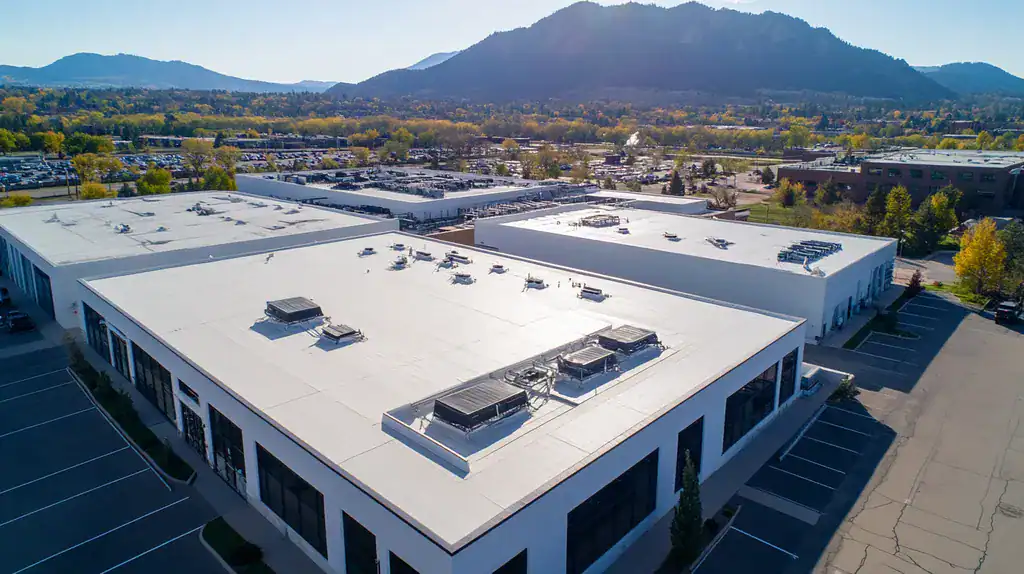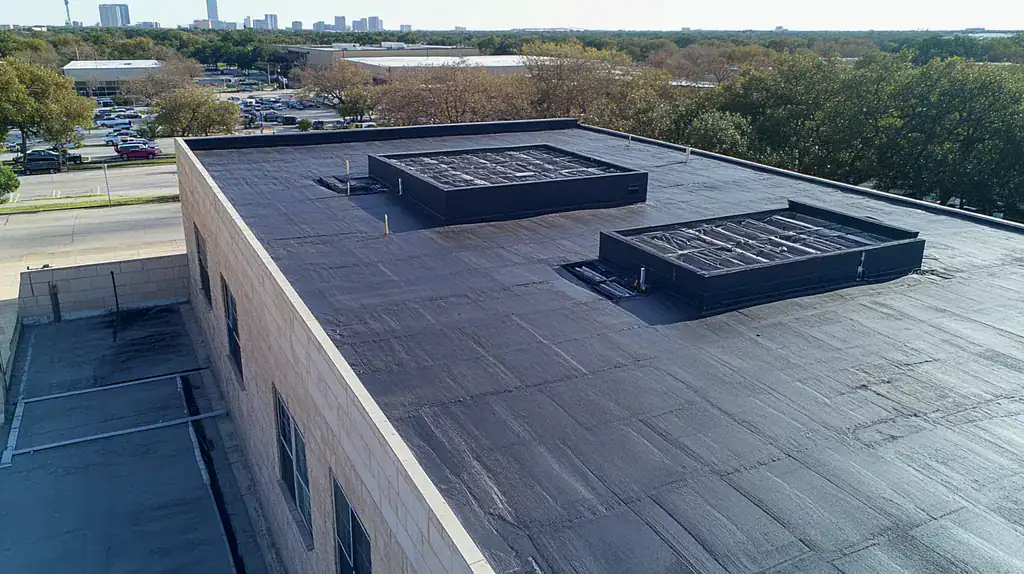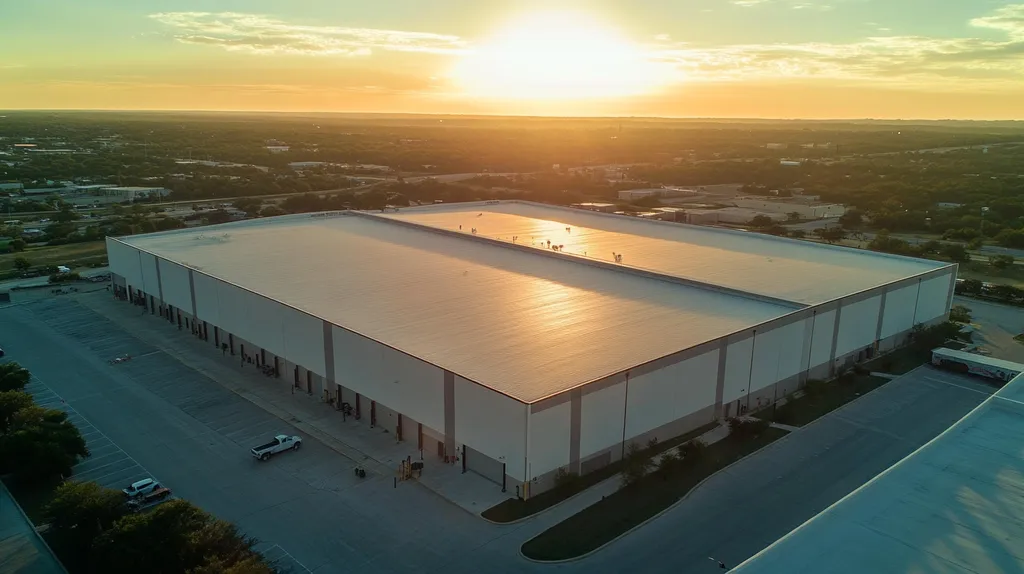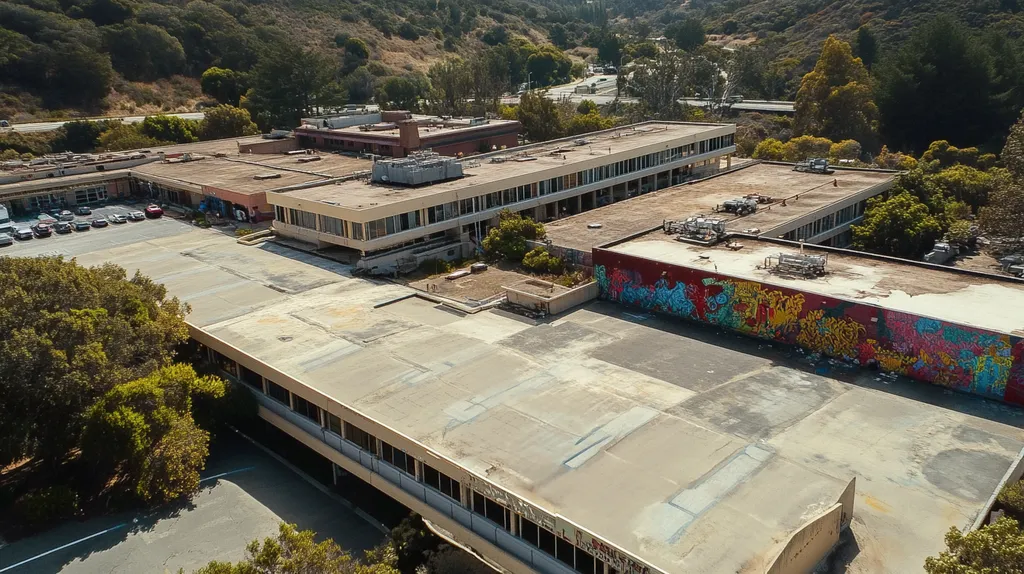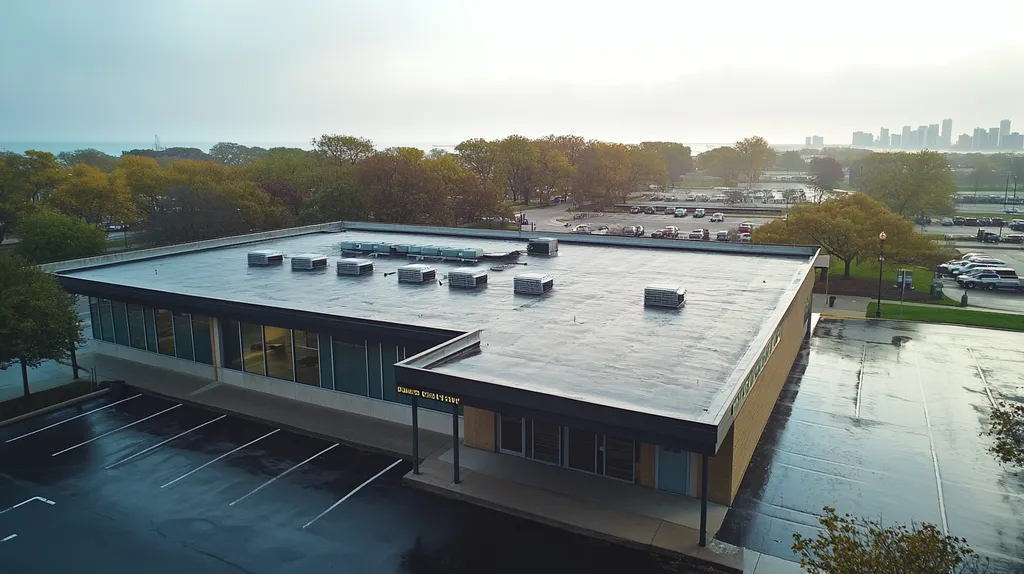Every year, falls from heights remain the leading cause of death in construction, with roofing operations accounting for 35% of these fatal incidents. For commercial property owners and facility managers, implementing proper roof safety measures isn’t just about regulatory compliance—it’s about preventing catastrophic accidents that can cost lives and millions in liability.
From fall protection systems and equipment protocols to emergency response planning, comprehensive safety measures form the foundation of successful commercial roofing operations.
This guide examines the critical components of roof safety, breaking down complex requirements into actionable steps that protect both workers and property investments.
SECTION 1: THE BASICS EXPLAINED
Safety measures in commercial roofing represent the critical difference between successful projects and potential disasters. Falls remain the leading cause of death in construction, with roofing work being particularly hazardous. For facility managers and building owners, understanding and implementing proper safety protocols isn’t just about compliance – it’s about protecting lives, assets, and business continuity.
What It Is (In Plain Language)
Commercial roof safety encompasses a comprehensive system of physical barriers, protective equipment, and work procedures designed to prevent accidents. This includes fall protection systems, proper equipment setup, and clearly defined safety zones.
The Occupational Safety and Health Administration mandates specific requirements for warning line systems, including placement at least 6 feet from roof edges and the ability to withstand 16 pounds of force. These systems must be highly visible with flags every 6 feet, while roof opening covers must support double the weight of workers and materials. (source: OSHA)
Beyond physical safeguards, safety measures include detailed job planning, weather monitoring, and equipment inspections. These elements work together to create a protective framework for all roofing activities.
Clear communication protocols and emergency response plans round out the safety system, ensuring rapid coordination if incidents occur.
Why It Matters (To Your Building)
Proper safety measures protect more than just workers – they safeguard your entire facility investment. Even minor safety oversights can result in major financial consequences through workers’ compensation claims, legal expenses, and project delays.
Insurance carriers closely evaluate safety protocols when determining coverage rates. Strong safety programs often qualify for premium reductions, while poor safety records can lead to coverage limitations or cancellation.
Building reputation also hinges on safety performance. Safety incidents can damage tenant relationships and property value, potentially affecting long-term revenue streams.
Additionally, proper safety measures help ensure quality workmanship by allowing roofers to focus on their tasks without compromise. This translates to better installation and longer roof life.
How It Works
Effective roof safety begins with thorough project planning and hazard assessment. This includes evaluating roof conditions, identifying access points, and mapping out equipment placement.
Implementation requires proper setup of physical safety systems like guardrails, warning lines, and fall arrest anchors. Each component must meet specific strength and placement requirements.
Daily safety briefings ensure all workers understand their roles and responsibilities. These meetings cover weather conditions, specific hazards, and emergency procedures.
Continuous monitoring by designated safety personnel ensures compliance throughout the project. Regular inspections verify that safety equipment remains properly installed and functional.
Documentation of all safety measures provides accountability and helps refine procedures for future projects. This creates a cycle of continuous safety improvement.
SECTION 2: PRACTICAL APPLICATIONS
Safety measures in commercial roofing directly impact both human lives and business operations. With falls remaining the leading cause of construction fatalities, implementing proper safety protocols is non-negotiable. Beyond protecting workers, comprehensive safety measures safeguard property investments, maintain operational continuity, and prevent costly liability issues. Understanding when and how to apply these measures effectively can mean the difference between project success and catastrophic failure.
Common Uses & Examples
The Occupational Safety and Health Administration mandates specific requirements for warning line systems, which must be placed at least 6 feet from roof edges and withstand 16 pounds of force. These systems require high-visibility flags every 6 feet, while roof opening covers must support double the weight of workers and equipment. (source: OSHA)
Daily equipment inspections form the foundation of ongoing safety practices. This includes checking fall protection gear, ensuring proper ladder placement, and verifying guardrail integrity before work begins.
Safety zones must be clearly marked and maintained throughout project duration. These designated areas help control access points and create buffer zones between active work areas and edges.
Regular safety briefings ensure all team members understand current conditions and requirements. These meetings address specific hazards, weather concerns, and emergency procedures.
When You Need It Most
Heightened safety measures become critical during specific scenarios, particularly during initial project phases. New installations and major repairs require additional precautions due to increased exposure and activity levels.
Weather changes demand immediate safety protocol adjustments. High winds, rain, or extreme temperatures can create hazardous conditions requiring work stoppage or additional safety measures.
Multiple contractor scenarios require enhanced coordination of safety measures. When different trades work simultaneously, clear communication and defined safety zones become even more crucial.
Emergency repairs present unique challenges requiring rapid but careful response. These situations demand strict adherence to safety protocols despite time pressures.
Interactions With Other Systems
Roofing safety measures must integrate seamlessly with building mechanical systems. This includes maintaining safe distances from HVAC units while ensuring necessary access for both roofing work and equipment maintenance.
Lightning protection systems require special consideration during safety planning. Workers must understand how to work around these systems without compromising their integrity or personal safety.
Access point planning must account for emergency systems and fire safety equipment. Safety measures should never block or impede access to critical building systems.
Building security systems often interact with roofing safety protocols. Coordination between security personnel and roofing teams ensures proper access control while maintaining safety standards.
SECTION 3: KEY TERMINOLOGY DECODED
Clear understanding of roofing terminology directly impacts worker safety and project success. When terminology confusion leads to miscommunication, the consequences can be severe – from incorrect material specifications to life-threatening safety oversights. For facility managers and building owners, mastering essential roofing terms isn’t about industry expertise – it’s about making informed decisions that protect both workers and assets.
Essential Terms Explained
Fall protection terminology forms the foundation of roof safety communication. Warning line systems must be placed 6 feet from roof edges, include high-visibility flags every 6 feet, and withstand 16 pounds of force. Roof opening covers must support double the weight of workers and materials that may be imposed on them. (source: OSHA)
“Personal fall arrest systems” refer to the combination of body harness, anchorage points, and connecting devices that prevent falls. Understanding these components ensures proper implementation and inspection.
“Safety monitoring systems” involve designated personnel watching workers in controlled access zones. This term encompasses specific responsibilities and positioning requirements for effective oversight.
“Controlled access zones” define areas where certain work can be performed without conventional fall protection. These zones require strict boundary marking and limited worker access.
Industry Jargon Translated
“Leading edge” refers to unprotected sides of a roof where work is actively occurring. This area requires specialized fall protection methods and increased vigilance.
“Anchorage point” describes the secure attachment point for lifelines or lanyards. These must support 5,000 pounds per attached worker or maintain a safety factor of two under supervision.
“Competent person” has specific legal meaning – someone capable of identifying hazards and with authority to take corrective action. This role carries significant responsibility for maintaining safety standards.
“Warning line system” encompasses more than just rope barriers – it’s a complete system of components working together to create visual and physical boundaries for worker safety.
Measurement & Units Simplified
Fall protection measurements follow specific standards that eliminate guesswork. Warning lines must be 34-39 inches high from the working surface – not approximate heights that might compromise safety.
Load ratings express maximum weight capacity in pounds-force (lbf) or kilonewtons (kN). These measurements ensure equipment can safely support required loads under normal use and emergency conditions.
Distance calculations for fall protection consider total fall distance, including free fall, deceleration distance, and harness stretch. Understanding these components prevents impact with lower levels.
Working surface measurements account for slope, which affects both fall protection requirements and worker mobility. Steeper slopes require additional safety measures beyond standard protocols.
SECTION 4: DECISION FACTORS
Making informed decisions about commercial roofing systems directly impacts worker safety, property protection, and long-term financial stability. Poor choices in materials, installation methods, or safety protocols can lead to catastrophic failures, injuries, and exponential cost increases. Statistics show that roofing accidents remain a leading cause of workplace fatalities, making safety-conscious decision-making paramount for facility managers and building owners.
Cost Considerations
Initial costs for commercial roofing projects must be weighed against long-term safety implications and maintenance requirements. While budget constraints are real, choosing lower-quality materials or inadequate safety systems inevitably leads to increased expenses through repairs, replacements, and potential liability.
Safety equipment investments directly impact worker protection and insurance premiums. Warning line systems must meet specific OSHA requirements, including placement 6 feet from roof edges and the ability to withstand 16 pounds of force, while roof opening covers must support double the weight of workers and materials. (source: OSHA)
Labor costs vary significantly based on contractor expertise and safety certification levels. Higher-skilled crews typically command premium rates but deliver superior installation quality and safer work practices.
Hidden costs like project delays due to safety violations or weather events must factor into budgeting decisions. These unexpected expenses can quickly eliminate any savings from choosing lower-cost options.
Performance Trade-offs
Material selection involves balancing durability, safety features, and installation requirements. Some materials offer excellent weather resistance but require specialized installation techniques that increase complexity and safety considerations.
Installation method choices significantly impact both immediate safety and long-term performance. Mechanical fastening may provide better wind resistance but increases penetration points and potential leak sources.
Climate considerations must influence material and system choices. Extreme temperature fluctuations, UV exposure, and precipitation patterns affect both installation safety requirements and long-term performance.
Safety system integration capabilities vary between roofing types. Some systems better accommodate permanent fall protection anchors and walkway systems, enhancing both installation safety and future maintenance access.
Lifespan & Durability Factors
System longevity directly correlates with exposure to safety risks during maintenance and repairs. Longer-lasting systems reduce the frequency of worker exposure to roof hazards.
Material degradation rates vary significantly based on environmental conditions and initial quality. Premium materials typically maintain their safety characteristics longer, reducing risk exposure over time.
Warranty terms often indicate expected performance duration and manufacturer confidence. However, warranties must be evaluated for exclusions that could impact safety-related repairs or modifications.
Life-cycle cost analysis should incorporate both direct maintenance expenses and safety-related considerations. This includes frequency of required inspections, ease of repairs, and compatibility with future safety system upgrades.
SECTION 5: COMMON CHALLENGES
Commercial roofing operations face critical safety challenges that can mean the difference between successful project completion and catastrophic failure. Industry data shows that roofing accidents remain one of the leading causes of workplace fatalities in construction, with falls accounting for nearly 40% of all roofing-related deaths. Understanding and addressing these challenges requires a systematic approach to identifying problems, recognizing warning signs, and implementing preventative measures.
Frequent Problems & Solutions
Warning line systems represent a critical safety requirement that’s often implemented incorrectly. The Occupational Safety and Health Administration mandates these systems be erected at least 6 feet from roof edges, or 10 feet when mechanical equipment is present, with covers capable of supporting twice the weight of workers and materials. (source: OSHA)
Communication breakdowns between multiple trades working simultaneously create dangerous situations. Establishing clear communication protocols and designated work zones helps prevent conflicts and ensures all parties maintain awareness of ongoing operations.
Material staging and equipment placement often create unnecessary hazards. Implementing detailed site logistics plans with designated storage areas and equipment zones reduces congestion and minimizes trip hazards.
Weather-related challenges frequently disrupt safe working conditions. Developing comprehensive weather monitoring protocols and clear stop-work criteria helps teams make informed decisions about continuing or suspending operations.
Warning Signs To Watch For
Physical damage to safety equipment, including frayed lanyards or compromised anchor points, indicates immediate intervention needs. Regular equipment inspections should document and address these issues before they lead to failures.
Worker fatigue manifests through decreased attention to safety protocols and increased near-miss incidents. Implementing mandatory rest periods and rotating demanding tasks helps maintain alertness and compliance.
Deteriorating roof conditions, such as soft spots or ponding water, create additional hazards. These conditions require immediate assessment and may necessitate additional safety measures during repairs.
Unauthorized modifications to safety systems or shortcuts in procedures signal a breakdown in safety culture. Swift correction and reinforcement of proper protocols prevents these practices from becoming normalized.
Preventative Approaches
Comprehensive training programs serve as the foundation for preventing safety incidents. Regular updates and refresher courses ensure workers maintain current knowledge of safety requirements and best practices.
Technology integration through digital inspection tools and monitoring systems provides early warning of developing issues. These systems help track equipment condition, worker compliance, and environmental hazards.
Pre-job planning meetings address potential hazards before work begins. These sessions should include detailed review of safety requirements, emergency procedures, and specific project challenges.
Documentation systems track incidents, near-misses, and equipment issues to identify patterns. Analysis of this data helps refine safety protocols and target areas needing additional attention.
Regular safety audits by third-party specialists help identify blind spots in existing protocols. These assessments provide objective evaluation of safety programs and recommend improvements based on current industry standards.
SECTION 6: NEXT STEPS & RESOURCES
Safety in commercial roofing directly impacts both human lives and financial outcomes. With roofing consistently ranking among construction’s most dangerous occupations, proper safety protocols can mean the difference between routine maintenance and catastrophic incidents. For facility managers and building owners, implementing comprehensive safety measures requires careful provider selection, thorough understanding of standards, and ongoing education.
Questions To Ask Providers
When evaluating roofing contractors, safety documentation should be a primary focus. Request detailed safety plans, incident reports, and EMR (Experience Modification Rate) ratings to assess their safety performance history.
Verify that contractors maintain proper insurance coverage and licensing. This includes workers’ compensation, general liability, and any specialized coverage required for specific project types.
Inquire about crew training programs and certification requirements. Professional contractors should demonstrate ongoing safety education and regular skills assessment for all team members.
Ask about specific fall protection strategies and equipment maintenance schedules. The Occupational Safety and Health Administration requires warning line systems placed 6 feet from roof edges with high-visibility flags every 6 feet, while roof opening covers must support double the weight of workers and materials. (source: OSHA)
Industry Standards & Guidelines
Safety standards form the foundation for protecting workers and property during roofing operations. Current regulations address fall protection, equipment requirements, and work procedures for various roof types and conditions.
Material handling guidelines specify proper storage, transportation, and placement of roofing supplies. These protocols help prevent overloading structures and minimize worker strain.
Emergency response procedures must align with local requirements and facility protocols. Clear communication channels and response plans should be established before work begins.
Quality control measures should integrate safety checkpoints throughout project phases. Regular inspections verify compliance with both safety standards and installation specifications.
Further Learning Simplified
Professional organizations offer targeted training programs addressing specific safety challenges. These resources help facility managers understand current requirements and emerging best practices.
Digital platforms provide convenient access to safety updates and compliance information. Mobile apps can streamline safety inspections and documentation while ensuring consistent protocol implementation.
Industry publications highlight evolving safety technologies and methodologies. Staying current with these developments helps inform safety planning and equipment decisions.
Networking events connect facility managers with safety experts and experienced peers. These connections provide valuable insights into practical safety solutions and common challenges.
The Bottom Line
With roofing accidents accounting for over one-third of construction fatalities annually, implementing proper safety measures isn’t optional—it’s imperative for survival.
Commercial property owners and facility managers must recognize that comprehensive roof safety extends far beyond basic compliance, encompassing everything from proper fall protection systems to emergency response protocols.
The financial implications of inadequate safety measures can devastate organizations through liability costs, insurance premium increases, and project delays.
By understanding and implementing the critical safety factors outlined in this guide, facility managers can protect both their workers and their investments while ensuring regulatory compliance and operational continuity.
The stakes are simply too high to compromise on roofing safety measures—lives and livelihoods depend on getting it right.
FREQUENTLY ASKED QUESTIONS
Q. What are basic safety measures for commercial roof work?
A. Basic safety measures include fall protection systems, training, and clear signage. They help prevent accidents by outlining proper procedures and using the right equipment for secure operations.
Q. When should safety measures be heightened for commercial roofs?
A. Safety measures should be heightened during initial project phases or adverse weather conditions. Increased activity levels or deteriorating conditions demand greater attention and stricter safety protocols to minimize risks.
Q. What key terminology should I know about commercial roof safety?
A. Important terms include fall protection systems, warning lines, and anchorage points. Familiarizing yourself with these terms helps in understanding safety protocols and ensuring effective communication among team members.
Q. What decision factors affect safety in commercial roof projects?
A. Key decision factors include material quality, installation techniques, and safety protocol adherence. Poor choices can lead to increased risks during projects and affect worker safety and financial stability.
Q. What common challenges do commercial roofs face regarding safety?
A. Common challenges include incorrect implementation of warning line systems and communication breakdowns. Addressing these issues ensures safer work conditions and reduces the likelihood of accidents during roofing operations.
Q. What questions should I ask roofing contractors about safety?
A. Ask about their safety plans, training programs, and previous incident reports. Understanding their safety performance history is crucial to ensuring they prioritize worker protection during roofing projects.
Q. How can I ensure ongoing safety in commercial roof work?
A. Ongoing safety can be ensured through regular training, thorough inspections, and effective communication. Incorporating these practices helps maintain a strong safety culture and reduces the risk of accidents over time.

